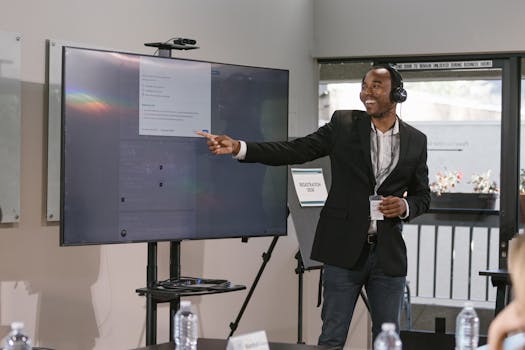Presentation skills are essential for effective communication in both personal and professional settings. Mastering these skills can boost confidence, enhance career opportunities, and improve interpersonal relationships.
In an age where technology enables global connections, being able to present ideas clearly becomes increasingly important. From job interviews to corporate meetings, strong presentation skills can set individuals apart.
This article explores practical steps to build and enhance your presentation skills. Whether you are speaking to an audience of one or one hundred, the following strategies will support your journey to becoming an engaging presenter.
Understanding Your Audience
Knowing your audience is the foundation of effective presentations. Each audience has unique interests and expectations. Researching these aspects helps tailor your content to their needs.
Starting with demographic factors like age, profession, and education level can guide the tone you use. Additionally, considering what motivates and interests them can help craft your message.
Engaging your audience from the beginning fosters a connection. Incorporating anecdotes or questions can pique their interest and encourage participation.
Furthermore, understanding potential knowledge gaps helps in choosing the right language and explanations. This ensures clarity and prevents confusion during your presentation.
Gather feedback afterward, if possible. This feedback will provide insights into audience engagement and areas for improvement for your next presentation.
Structuring Your Presentation Effectively
A well-structured presentation promotes clarity and comprehension. A clear beginning, middle, and end help guide your audience through your message.
Start with a strong introduction that outlines key points. This prepares the audience for what they can expect and heightens their interest. Use visual aids when necessary to reinforce your message.
In the body of your presentation, develop each point thoroughly. Use transitions to maintain flow and connect ideas smoothly. This helps the audience follow your narrative without feeling lost.
Finally, wrap up with a compelling conclusion. Summarize key takeaways and reiterate why they matter. A powerful closing leaves a lasting impression on your audience.
In summary, structure acts as a roadmap. It keeps both you and your audience focused on the message and makes the experience more engaging.
Practicing Your Delivery
Practice is crucial in building your presentation skills. Rehearsing helps reduce anxiety and increases familiarity with your material. Begin by practicing in front of a mirror.
Next, consider recording your practice sessions. Watching these recordings allows you to observe body language, pacing, and vocal tone. Self-analysis is an effective way to identify areas for improvement.
It’s also beneficial to practice in front of an audience, such as family or friends. This provides an opportunity for real-time feedback and boosts confidence in your delivery.
Utilize techniques such as pause and breathe to control nervousness. Pausing allows you to gather your thoughts, while taking deep breaths helps manage anxiety.
Moreover, continuous practice leads to improvement. Embrace every opportunity to present, as each experience builds competence and self-assurance.
Utilizing Visual Aids
Visual aids enhance the effectiveness of presentations. They make complex information more accessible and retain audience attention. Use slides, images, or charts to illustrate your points.
Ensure that visual aids are clear and relevant. Overloading slides with text can detract from your message. Aim for simplicity and focus on key ideas instead.
Incorporating visuals also caters to different learning styles. Some audience members retain information better through visual stimuli than spoken word. Therefore, using visuals can strengthen understanding.
It’s crucial to integrate visuals seamlessly. Refer to them during your presentation, guiding the audience through the narrative, rather than letting them distract from your message.
Lastly, practice using your visuals in conjunction with your spoken delivery. This ensures a cohesive presentation where words and images work in harmony.
Engaging Your Audience
Active engagement keeps your audience interested and attentive. Start by asking open-ended questions to encourage participation. This fosters a two-way interaction that enriches the experience.
Use storytelling techniques to relate your content to real-world scenarios. Sharing personal anecdotes humanizes your presentation and allows the audience to connect on a deeper level.
Furthermore, consider incorporating interactive elements such as polls or quizzes. These not only entertain but also reinforce the information shared during your presentation.
Body language plays a significant role in engagement. Make eye contact, use gestures, and move around to create a dynamic presence that captivates your audience.
Lastly, show enthusiasm for your topic. Passion is contagious, and an enthusiastic presenter is more likely to inspire engagement from their audience.
Handling Questions and Feedback
Handling questions during presentations can be daunting. However, it’s critical to view it as an opportunity for engagement rather than a challenge. Encourage questions throughout and at the end.
Practice active listening to ensure you fully understand the questions being asked. This shows respect for the inquirer and helps you provide more thoughtful responses.
If a question is unclear, don’t hesitate to ask for clarification. This not only helps you address the inquiry accurately but also engages the audience member further.
Moreover, remain calm and composed, even with challenging questions. Your demeanor reflects confidence and professionalism, which can influence audience perception positively.
Finally, accept constructive criticism gracefully. Feedback provides valuable insights for improvement and demonstrates your willingness to learn and adapt.
Conclusion
Building presentation skills is a journey of practice, feedback, and refinement. By understanding your audience, structuring your content effectively, and engaging dynamically, you can improve significantly.
Visual aids, active engagement, and the ability to handle questions contribute to effective presentations. Embrace each opportunity to present and learn from every experience.
Ultimately, strong presentation skills can have a profound impact on your personal and professional life. Invest time into developing these skills, and the benefits will follow.
